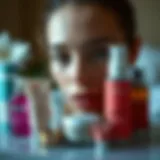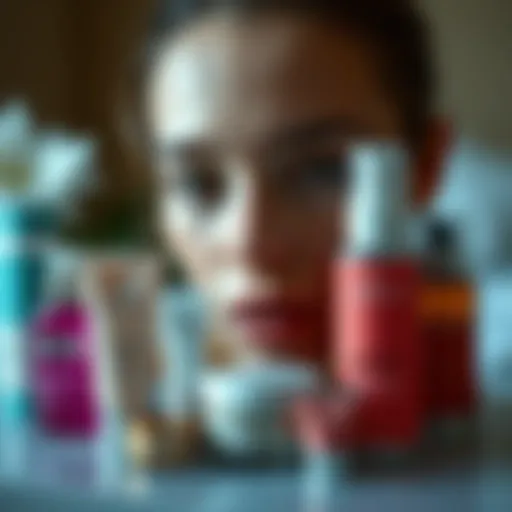A Comprehensive Guide to Phototherapy for Acne


Intro
Acne is a common skin condition that affects individuals across various age groups, particularly during adolescence and early adulthood. The physical appearance of acne can significantly impact self-esteem and quality of life. Traditional treatments often involve topical or oral medications that may not always provide satisfactory results. In recent years, phototherapy has emerged as a promising alternative in the realm of acne treatment, utilizing light to target and reduce acne lesions.
This article delves into the mechanisms through which phototherapy operates, the various types available, and the clinical evidence supporting their effectiveness. Furthermore, it examines potential side effects and offers considerations for those thinking about integrating phototherapy into their acne management plans. By synthesizing this information, readers will gain a comprehensive understanding of how phototherapy can play a crucial role in the fight against acne.
Tips and How-Tos
When considering phototherapy for acne, it is essential to understand that this treatment is not a standalone solution. Instead, it can be integrated into a broader skincare regimen that considers individual skin types, lifestyle factors, and existing acne treatments. Here are some useful tips for adopting phototherapy effectively:
Skincare Routines for Different Skin Types
- Oily Skin: Incorporate salicylic acid cleansers to help manage excessive oils. Follow up with a light moisturizer to prevent drying the skin excessively.
- Dry Skin: Use gentle, hydrating cleansers, and ensure your skincare routine includes thick moisturizers rich in emollients and humectants to maintain skin moisture.
- Sensitive Skin: Opt for fragrance-free and alcohol-free products. Consult a dermatologist for recommendations suited specifically to your skin condition.
It is advisable to consult professional dermatologists familiar with phototherapy to ensure optimal results while avoiding adverse reactions. Each type of acne may respond differently to treatment, making personalized care vital.
Sustainable Practices
Incorporating sustainable practices into acne treatment routines is increasingly significant. Although phototherapy itself is primarily focused on the skin, adopting eco-friendly habits can enhance overall well-being.
Eco-Friendly Practices in Skincare
- Opt for brands that prioritize sustainable ingredients in their formulations to minimize environmental impact.
- Dispose of skincare and phototherapy-related products properly, adhering to local disposal guidelines to reduce waste.
- Choose multi-functional products to limit the number of separate skincare items, which reduces packaging waste.
Celebrating Diversity in Beauty
Recognizing the diversity in how acne manifests and is treated across different cultures can be enlightening. Factors such as skin type, climate, and dietary habits may influence acne treatment responses.
Inclusive Beauty Practices
- Seek out brands that cater to various skin tones and skin types to ensure a broad range of options for acne treatments.
- Engaging with communities on platforms such as Reddit or Facebook can provide support and insights from individuals with similar skin concerns, fostering a sense of inclusivity.
Acne treatment must be tailored to individual needs, and understanding different approaches globally can inspire new ideas to combat this persistent issue. Each person’s journey with acne is unique, and solutions should reflect that diversity.
"Personalized skincare is essential for effective acne management, particularly with the options presented by phototherapy."
Understanding Acne
Acne is a condition that affects a large portion of the population, particularly during adolescence and early adulthood. Understanding acne is fundamental for effective treatment options like phototherapy. In this section, we will delve into the significance of comprehending this skin condition along with its underlying causes and implications for treatment.
Acne arises when hair follicles become clogged with oil and dead skin cells. It can occur anywhere on the body, but is most commonly found on the face, back, and shoulders. Knowing the biological and environmental factors that lead to acne formation helps in targeting the treatment more effectively.
In addition, understanding acne contributes to demystifying the condition for those who suffer from it.
"Acne is not merely a cosmetic issue; it can affect emotional well-being and self-esteem."
Learning about its causes and effects allows individuals to take proactive measures to manage their skin health better.
The Biological Basis of Acne
At the heart of acne is the sebaceous gland, which produces sebum, an oily substance that lubricates the skin. This production is influenced by hormonal changes, particularly during puberty, which often triggers increased oil production. Consequently, pores can become clogged, leading to the growth of Propionibacterium acnes, a bacteria that contributes to inflammation.
Beyond hormones, genetics also plays a role in acne susceptibility. Individuals may inherit a predisposition to acne, making some more prone to develop it than others. Inflammation resulting from this process manifests in the form of pimples, cysts, and scars.
Factors Contributing to Acne Development
Several factors contribute to the development of acne, and recognizing these can aid in prevention and treatment.
- Hormonal Fluctuations: Hormones influence sebum production, especially during puberty, menstrual cycles, or pregnancy.
- Diet: Some studies suggest that certain foods, such as dairy or high-glycemic-index items, may exacerbate acne.
- Stress: Psychological stress can worsen skin conditions, including acne.
- Skin Care Products: Comedogenic products can clog pores, increasing the risk of breakouts.
- Environmental Factors: Pollution and humidity can also impact skin health.
Understanding these factors is essential for women of all ages as it empowers them to make informed choices about their skincare routines and treatment strategies.
Preamble to Phototherapy
Phototherapy represents a pivotal advancement in the field of dermatology, especially concerning acne treatment. As more individuals seek effective and less invasive solutions for their skin problems, phototherapy emerges as a relevant and powerful treatment option. This section delineates the importance of understanding phototherapy, emphasizing its role, benefits, and the considerations to be mindful of.
The primary allure of phototherapy lies in its ability to leverage specific light wavelengths to target acne lesions directly. This approach not only addresses the symptoms of acne but also targets the underlying physiological processes that contribute to its development. Understanding this treatment modality is essential for patients considering alternative or supplementary options to traditional acne therapies.
Definition of Phototherapy
Phototherapy involves the use of light to treat medical conditions, including acne. In this context, it primarily utilizes specific types of light, such as blue and red wavelengths, known for their efficacy in reducing inflammation and bacteria associated with acne. The application of phototherapy can be performed through various devices, like handheld units or larger machines used in clinical settings. This process is non-invasive, making it a favorable choice for many patients.
Historical Overview of Phototherapy in Dermatology
The origins of phototherapy in dermatology date back to the late 19th and early 20th centuries when physicians began using sunlight to treat skin disorders. Early treatments focused on the natural sunlight's restorative properties, which laid the groundwork for modern phototherapy practices. Over time, advancements in technology and a deeper understanding of light's effects on the skin led to the development of specialized devices capable of delivering targeted wavelengths.
In the late 20th century, studies introduced light's antibacterial properties, which marked a turning point in acne treatment methodologies. As research expanded, dermatologists embraced phototherapy, integrating it into comprehensive acne management plans. Today, phototherapy continues to evolve, incorporating cutting-edge technologies and new wavelengths, thus expanding its effectiveness and application in treating acne-related conditions.
Mechanisms of Action in Acne Treatment
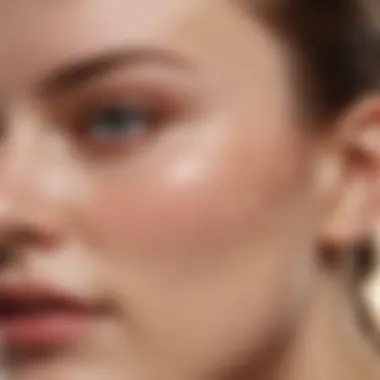

Understanding the mechanisms of action in acne treatment is crucial for comprehending how phototherapy can alleviate this prevalent skin condition. Phototherapy employs specific light wavelengths to target different aspects of acne, offering a multifaceted approach to treatment. It is important to recognize that acne is not solely a matter of skin appearance; it involves complex biological processes. By exploring how phototherapy influences these processes, we can appreciate its role in modern dermatology.
How Phototherapy Targets Acne Pathogenesis
Phototherapy acts mainly through its effects on the acne pathogenesis, which includes several interrelated factors such as hyperactive sebaceous glands, abnormal keratinization, and the presence of Propionibacterium acnes. Light wavelengths utilized in phototherapy aim to address these factors by activating various skin responses.
- Sebum Production: Some light therapies, like red light, can reduce sebum production by influencing hormonal pathways.
- Cellular Turnover: Phototherapy promotes a faster turnover of skin cells. This is significant because when dead skin cells accumulate, they can clog pores and lead to the formation of acne lesions.
- Inflammation Reduction: By modulating inflammatory processes within the skin, phototherapy can diminish the redness and swelling associated with active acne.
With these mechanisms, phototherapy works strategically against the myriad of factors that contribute to acne formation. Studies suggest that patients often experience a decrease in both the number and severity of lesions following treatment.
Role of Antibacterial Effects
Antibacterial properties are another pivotal element in the effectiveness of phototherapy. Phototherapy, particularly blue light therapy, operates on the principle of photoinactivation.
- Targeting Bacteria: The specific wavelengths used can penetrate the skin and are absorbed by Propionibacterium acnes, which is a major contributor to inflammatory acne. This absorption generates reactive oxygen species that effectively kill the bacteria without harming surrounding tissues.
- Preventing Resistance: Unlike traditional antibiotics, phototherapy does not lead to bacterial resistance. This is another compelling reason to consider phototherapy as a long-term treatment option.
Phototherapy offers a dual-action mechanism: it not only targets the sources of inflammation but also reduces the bacterial load on the skin. This results in improved overall skin health, making it a valuable component in a comprehensive acne treatment plan.
This integrated understanding of phototherapy's mechanisms reinforces its significance as a modern treatment strategy for acne. It addresses both the biological factors and the underlying pathogens that contribute to this condition.
The exploration of these mechanisms lays the groundwork for understanding how various types of phototherapy can be effectively utilized in managing acne.
Types of Phototherapy for Acne
Phototherapy is becoming a key player in acne treatment. Different types are available, each utilizing specific wavelengths of light to target acne effectively. Understanding these types is crucial in choosing the right treatment. The most common methods are blue light therapy, red light therapy, and combination therapies.
Blue Light Therapy
Mechanism of Action
Blue light therapy works primarily by targeting the bacterium Propionibacterium acnes, which is known to trigger acne lesions. This light penetrates the skin and causes a phototoxic effect on these bacteria, reducing their population. This mechanism is notable for its non-invasive approach. As it targets specific bacteria without affecting surrounding skin cells much, it is a popular choice for those wanting effective results without significant side effects. The advantage of this therapy is that it does not require topical medications.
Efficacy Studies
Efficacy studies on blue light therapy have shown promising results. Research indicates that regular treatments can significantly reduce acne lesions over time. Many studies confirm the reduction in acne severity, with some showing results within weeks of treatment. Moreover, the treatment is generally well-tolerated, making it a favored option for many patients. However, individual responses can vary, and some may not see optimal results, which leads to concerns about it being a one-size-fits-all solution.
Red Light Therapy
Mechanism of Action
Red light therapy complements acne treatment in a different way. This therapy promotes healing and reduces inflammation, aiding skin repair. The red wavelengths penetrate deeper into the skin, helping to stimulate collagen production and improve overall skin texture. Its anti-inflammatory properties can be especially beneficial for those suffering from severe acne. This therapy's advantage is the promotion of healthier skin post-treatment.
Efficacy Studies
Recent efficacy studies indicate that red light therapy can enhance overall skin health. Many patients report reduced redness and improved skin texture alongside a decrease in acne. However, it may not target the bacteria that cause acne as effectively as blue light therapy. This variability can serve as a limitation for some individuals seeking immediate results directly targeting acne lesions.
Combination Therapies
Rationale for Combination Treatments
Combination therapies utilize both blue and red light, taking advantage of their unique effects. By addressing bacteria while promoting healing, this approach offers comprehensive treatment for acne. The rationale is simple: combining treatments can lead to better results than using either therapy individually. This comprehensive approach appeals to a broader audience, particularly those with persistent or severe acne.
Clinical Evidence
Clinical evidence supporting combination therapies shows increased effectiveness in treating acne. Studies report a significant reduction in acne lesions when both blue and red light are used together. Additionally, patients often experience reduced inflammation and improved skin texture. However, the need for further studies remains to confirm long-term efficacy and safety, as results can significantly differ among patients.
"Utilizing a combination of light therapies can enhance acne treatment outcomes and improve patient satisfaction."
In summary, understanding the available types of phototherapy for acne is vital for choosing the right approach. Each method offers unique benefits, and considering individual skin types and conditions can lead to informed treatment decisions.
Clinical Evidence Supporting Phototherapy
Phototherapy has gained attention within dermatological circles as a promising treatment for acne. Understanding the clinical evidence supporting its use is crucial for discerning potential patients and healthcare professionals alike. This section delves into recent studies and comparative analyses with traditional acne treatments. The insights gained from these investigations inform both efficacy and the integration of phototherapy into broader acne management strategies.
Review of Recent Studies
Recent studies have highlighted the effectiveness of phototherapy in reducing the severity of acne lesions. In a controlled trial involving blue light therapy, participants showed significant reductions in acne lesions over 12 weeks compared to those receiving a placebo. This result aligns with others suggesting that phototherapy, specifically targeting the Propionibacterium acnes bacteria, leads to a decrease in active acne.
A notable study published in the Journal of Dermatological Treatment asserted that red light therapy could further enhance healing and reduce inflammation. The study demonstrated a marked improvement in skin texture and fewer inflammatory lesions, indicating that different wavelengths of light may possess distinct advantages in acne treatment.
"Clinical research suggests that phototherapy can deliver considerable improvements for patients with moderate to severe acne, complementing traditional therapies."
Comparative Studies with Traditional Treatments
In evaluating the role of phototherapy vis-à-vis traditional acne treatments, such as topical retinoids and oral antibiotics, several studies offer enlightening comparisons. Research published in Dermatology and Therapy analyzed the efficacy of blue light therapy against standard treatments. The results suggest that while traditional treatments are effective, phototherapy offers a lower risk of side effects and longer-term management of acne without the harsh effects typical of some medications.
Moreover, a systematic review indicated that combining phototherapy with conventional treatments could enhance overall effectiveness. For patients who have not responded to topical retinoids or who wish to avoid systemic medications, integrating light therapy presents a viable option for achieving clearer skin.
Patients considering phototherapy should discuss their options thoroughly with their dermatologists. These conversations can address individual needs and preferences, ensuring that the most appropriate and effective treatment plan is established.
Benefits of Phototherapy for Acne
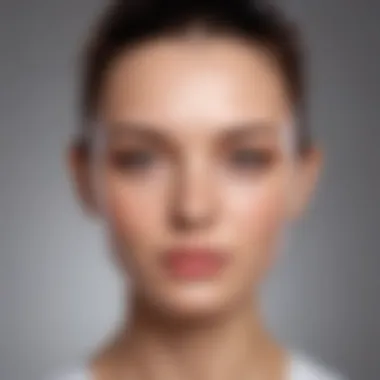

Phototherapy offers a variety of benefits for acne treatment, making it a compelling option for individuals seeking effective solutions. This technique leverages specific light wavelengths to target acne lesions, thus reducing inflammation and killing bacteria. Understanding its benefits can help patients make informed decisions regarding their skin care strategies. The benefits can be categorized into non-invasiveness, lower risk of side effects, and an overall improvement in skin health.
Non-Invasiveness and Painlessness
One of the primary advantages of phototherapy is its non-invasive nature. Unlike some traditional treatments, such as chemical peels and certain medications, phototherapy does not require any surgical procedures. This characteristic makes it an appealing choice for those who wish to avoid the discomfort associated with more invasive methods.
Patients typically report that phototherapy sessions are painless. The sensation is often described as warm or soothing rather than irritating. For instance, both blue light and red light therapies provide a comfortable treatment experience, allowing individuals to undergo sessions without significant distress.
Patients appreciate this aspect, especially when compared to topical treatments that may cause stinging or burning sensations. The non-invasive quality, combined with the lack of pain, encourages more patients to stick with their treatment plans. This consistency is crucial for successful acne management over time.
"I found phototherapy to be much gentler than the creams I used before. I didn’t experience any discomfort, which was a huge relief for me."
Lower Risk of Side Effects
Phototherapy generally presents a lower risk of side effects when compared to conventional therapies for acne. Medications like isotretinoin or certain antibiotics can lead to a range of adverse reactions, from skin sensitivity to more serious issues like liver damage. In contrast, the light therapy methods are much safer, typically resulting in mild and temporary reactions, if any at all.
Common side effects associated with phototherapy may include slight redness or irritation that usually subsides quickly after treatment. More severe reactions are infrequent. This makes phototherapy particularly suitable for individuals with sensitive skin types.
Additionally, phototherapy does not interfere with hormonal changes or other biological processes in the same way that some medications can, which allows for a more holistic approach to treatment. This factor not only minimizes risks but also emphasizes the compatibility of phototherapy with various skin types and conditions, making it a favored choice among dermatologists.
In reviewing the spectrum of benefits presented by phototherapy, it is clear that this approach holds a significant place in modern acne management strategies. By emphasizing non-invasiveness and lower risks, patients can approach their treatment with confidence and a stronger likelihood of adherence. It encourages a more enduring commitment to achieving clearer skin.
Potential Side Effects and Risks
Understanding the potential side effects and risks associated with phototherapy is essential for anyone considering this treatment for acne. While phototherapy is generally deemed safe and effective, it is crucial to approach it with a cautious mindset. Being aware of the adverse effects can facilitate better decision-making and enhance the overall treatment experience.
Often, patients may overlook the risks involved with new treatments, focusing solely on the benefits. However, knowing the downsides prepares individuals for realistic outcomes and encourages proactive management strategies. An informed patient is undoubtedly better equipped to navigate their dermatological journey.
Common Side Effects
Phototherapy might induce several common side effects that vary in intensity. Some frequently reported side effects include:
- Skin Irritation: Redness, dryness, or flaking in treated areas.
- Mild Pain or Discomfort: Some individuals experience a tingling sensation during or after treatment.
- Photosensitivity: Increased sensitivity to light, requiring precautions to avoid sun exposure subsequently.
While these effects are usually temporary and resolve shortly after treatment, they can still create discomfort. Monitoring your skin’s reaction post-treatment is necessary, and communicate any persistent issues with a dermatologlst. This information can guide further treatment adjustments or interventions as appropriate.
Considerations for Sensitive Skin
For individuals with sensitive skin, additional care is necessary when undergoing phototherapy. People with conditions like eczema or rosacea may react differently compared to individuals with normal skin. Some considerations include:
- Pre-Treatment Evaluation: An in-depth assessment is crucial. A dermatologista Can determine if the treatment is suitable for your skin’s specific needs.
- Patch Testing: Trying phototherapy on a small skin area can identify any latent negative reactions.
- Hydration and Moisturization: Keeping affected areas moisturized before and after treatment lessens the risk of irritation.
It is critical to consult with a qualified dermatologlst about any skin concerns. Treatment plans may need to be adjusted based on individual skin sensitivity.
"An informed decision relies heavily on understanding both potential benefits and risks involved in any treatment."
Engaging in meaningful discourse with health professionals ensures that safeguarding your skin’s integrity remains a priority while pursuing effective acne management.
Who Can Benefit from Phototherapy?
Phototherapy presents a unique avenue for managing acne, particularly for individuals who have not found relief through traditional treatments. Its emphasis on non-invasive methods aligns well with the increasing interest in alternative therapies for skin conditions. Understanding who can benefit from phototherapy is crucial, as it helps to identify those who are most likely to experience positive outcomes.
Identifying Suitable Candidates
Not everyone will respond to phototherapy in the same way. Certain groups may experience more significant benefits. Individuals with mild to moderate acne are typically the best candidates. This includes those who have inflammatory acne, such as papules and pustules.
Some potential candidates for phototherapy include:
- Young adults and teenagers: Hormonal changes during adolescence can lead to an increase in acne lesions. Many in this demographic seek effective treatment options.
- Adults: As people age, acne can persist due to hormonal shifts or stress. Adults seeking a holistic approach to skin health may find phototherapy beneficial.
- Individuals with skin types that are not reactive: Certain skin types can tolerate treatment better, making phototherapy a safe option for them.
- Those with specific health conditions: Patients who cannot tolerate systemic medications due to side effects may opt for phototherapy as a viable alternative.
Phototherapy is also suitable for patients seeking to avoid the side effects associated with more aggressive acne treatments. Unlike medications like isotretinoin, phototherapy typically presents a lower risk regarding adverse side effects.
Limitations of Treatment
While phototherapy offers promise, it is not a universal solution. There are clear limitations to consider when evaluating its effectiveness. Each individual's response to treatment will vary, making it essential to set realistic expectations.
Several notable limitations include:
- Not effective for everyone: A subset of patients may not see notable improvements even with consistent treatments.
- Severity of acne: Phototherapy is generally most effective for mild to moderate acne. Those with severe cystic acne may require additional treatments or combination therapies for desired results.
- Treatment regimen: Commitment to frequent sessions is necessary; those unable to commit to this may not experience the full benefits.
- Cost and accessibility: Phototherapy can be expensive and may not be available at all clinics, creating barriers for some patients.
Integrating Phototherapy into Acne Treatment Plans
Integrating phototherapy into acne treatment plans is crucial for optimizing therapeutic outcomes. As medical professionals continue to explore advanced methods to manage acne, phototherapy stands out due to its unique mechanisms and efficacy. The application of light therapy can enhance existing treatment regimens by targeting the underlying causes of acne. By incorporating phototherapy, patients can achieve better control over their skin condition while reducing reliance on systemic medications, many of which come with significant side effects.
Pre-Treatment Assessment
Before proceeding with phototherapy, a thorough pre-treatment assessment is essential. This step involves gathering the patient’s medical history, examining the severity of the acne, and evaluating skin type.
Factors to consider during the assessment include:
- Severity of Acne: Understanding whether the acne is mild, moderate, or severe informs the therapeutic approach.
- Skin Sensitivity: Patients with sensitive skin may require tailored settings or alternative approaches to avoid adverse reactions.
- Previous Treatments: Knowledge of prior treatments and their outcomes can provide insight into how phototherapy may fit into the patient's overall care plan.
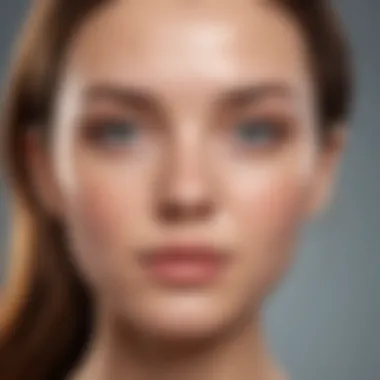

High-quality clinical assessments facilitate customized treatment, ensuring the chosen method aligns with patient needs and expectations.
Combining with Topical and Systemic Treatments
Phototherapy is often used in conjunction with topical and systemic treatments for optimal results. Combining therapies can significantly enhance efficacy, as each approach targets different acne pathophysiologies.
Benefits of combination therapy include:
- Enhanced Results: Using phototherapy alongside topical agents like benzoyl peroxide or salicylic acid can lead to faster and more effective improvements in acne lesions.
- Reduced Dosage of Oral Medications: When phototherapy is included in a treatment plan, it may allow for lower dosages of systemic treatments, minimizing potential side effects.
- Comprehensive Action: Each treatment can complement the others—phototherapy can reduce bacterial load, while topical treatments can manage excess sebum production and inflammation.
It is essential, however, to coordinate treatment sessions to avoid irritation. Healthcare providers must educate patients about the synergy between treatments, emphasizing the importance of adherence to prescribed regimens for the best possible outcomes.
Future Directions in Phototherapy Research
The field of phototherapy for acne treatment is continuously evolving. Future research directions are vital not only for improving treatment efficiency but also for expanding the range of options available to patients. Understanding the potential advancements and alternative approaches in phototherapy could significantly enhance acne management strategies across diverse patient demographics.
Advancements in Technologies
Recent advancements in phototherapy technologies bring forth new possibilities for acne treatment. Innovations such as LED devices have gained popularity due to their effectiveness and versatility. Clinical studies have demonstrated that these devices can target acne lesions more precisely while minimizing skin damage.
Moreover, integrating mobile applications for monitoring treatment response represents a noteworthy trend. These applications can help patients track their progress and provide dermatologists with data to tailor treatment plans effectively.
In addition to these technologies, improvements in light delivery systems may enhance the penetration of therapeutic wavelengths into the skin, increasing the effectiveness of treatments. The development of portable devices allows more patients to access treatment in various settings, promoting adherence to therapy.
Exploring New Light Frequencies
Researchers are increasingly interested in exploring new light frequencies for acne control. Beyond traditional blue and red light, other wavelengths could prove beneficial. Emerging studies indicate that infrared light may also play a role in reducing inflammation and promoting skin healing.
The exploration of combined wavelengths is another area of investigation. Researchers theorize that using a mix of different light frequencies may target various aspects of acne pathogenesis simultaneously. This approach could yield more comprehensive results and address not just the surface symptoms but also underlying causes of acne.
Ultimately, as new wavelengths are tested, it is crucial to assess their safety and efficacy. This evaluation will ensure that newly developed phototherapy options provide real benefits without introducing adverse effects.
Investing in research for advanced light technologies not only aims to enhance acne treatment but also holds potential for addressing skin conditions across multiple age groups and types.
Patient Experiences and Testimonials
The significance of patient experiences and testimonials in the context of phototherapy for acne cannot be overstated. These narratives provide real-world insights into the treatment's efficacy, often filling gaps that clinical studies may leave open. They offer a valuable perspective on how phototherapy affects people’s daily lives, emotions, and self-esteem.
Sharing personal stories helps to humanize the treatment journey. They reflect the diverse experiences among individuals undergoing phototherapy, capturing both the successes and challenges faced. These testimonials can serve as a source of encouragement for those contemplating this treatment option. They can also highlight aspects such as the duration of treatment, frequency of sessions, and immediate results, which are often not addressed in medical literature.
Furthermore, these narratives contribute to a better understanding of patient expectations and the psychological aspects of dealing with acne. This knowledge can enhance clinical practice by encouraging practitioners to consider their patients' mental health along with physical outcomes.
In summary, the voices of those who have experienced phototherapy provide crucial insights. They reveal the emotional journey of treatment and foster a deeper connection within the community, enhancing support and motivation for others.
Case Studies of Successful Treatments
Case studies of successful treatments amplify the narrative surrounding phototherapy for acne. These detailed accounts showcase individuals who have undergone phototherapy and achieved significant improvements in their skin condition.
One compelling case involves a young woman named Sarah, who struggled with cystic acne for years. After trying various topical treatments without success, she turned to blue light therapy. Within a few weeks, Sarah reported a noticeable reduction in inflamed lesions and overall skin clarity. Her journey underscores the potential for phototherapy to provide relief where other treatments fail.
Another example is that of Maria, who combined red light therapy with her traditional acne regimen. This combination led to reduced inflammation and improved skin texture. Maria's case exemplifies how individualized treatment plans incorporating phototherapy can lead to successful outcomes.
These case studies, while limited in number, serve to inspire others facing similar challenges. They encourage exploration of phototherapy as a viable treatment pathway, emphasizing the importance of a tailored approach to acne management.
Challenges Faced by Patients
While the benefits of phototherapy for acne are notable, it is important to address the challenges some patients may experience. Understanding these hurdles can provide a balanced perspective.
One common challenge is the cost of sessions. Some individuals may find it difficult to afford regular phototherapy treatments, especially when multiple sessions are necessary for optimal results. Health insurance coverage for phototherapy can vary, further complicating access for some patients.
Another issue pertains to time commitment. Treatment schedules may demand a significant time investment, with sessions occurring several times a week. This can interfere with personal or professional responsibilities, creating added stress for patients.
Additionally, not every patient responds to phototherapy in the same way. Factors such as skin type, acne severity, and treatment adherence can influence outcomes. Some individuals may experience minimal improvement or even temporary flare-ups after beginning treatment. This variability in response can be discouraging for many.
Overall, while phototherapy presents a promising option for acne treatment, it is essential for patients to be aware of potential challenges. Being informed can help them navigate their treatment journey more effectively.
Closure
The conclusion of the article serves as a vital component, synthesizing the information presented throughout. It underscores the significance of phototherapy as an effective acne treatment option. The discussion addresses its mechanisms, types, and clinical evidence, providing a comprehensive perspective for readers. In this section, we emphasize key elements driving the topic's relevance.
Summary of Key Points
In summarizing the key points, we revisit the main aspects discussed:
- Phototherapy Mechanisms: Understanding how phototherapy utilizes specific light wavelengths to target acne.
- Types of Phototherapy: Differentiating between blue light therapy, red light therapy, and combination therapies.
- Clinical Evidence: Highlighting the supportive research that validates the efficacy of phototherapy as a treatment option.
- Benefits and Drawbacks: Weighing the advantages such as non-invasiveness against potential risks and side effects.
- Patient Considerations: Recognizing who might benefit from these treatments and integrating phototherapy within a broader acne management plan.
This summary is designed to reinforce the essential takeaways, facilitating a deeper understanding of how phototherapy can impact acne treatment.
Final Thoughts on Phototherapy for Acne
In final thoughts, it is essential to recognize that phototherapy is not a panacea for all acne sufferers. However, its role in many individuals' acne treatment regimens is noteworthy. By understanding the mechanisms and clinical evidence, patients and practitioners can make informed decisions tailored to specific needs. Phototherapy stands out for its non-invasive nature, providing a viable alternative or complement to traditional treatments. As technology advances, future research could enhance customizability and efficacy, making it a more attractive option for women of all ages.
Ultimately, by focusing on education and awareness of phototherapy's potential, individuals can approach acne management with better-informed strategies. This newfound knowledge empowers them to take control of their skin health and make choices aligned with their personal and aesthetic goals.
"Knowledge is power; in the domain of skin health, empowerment allows for more effective decision-making."
By engaging with these guidelines and insights on phototherapy, individuals are better equipped to tackle the challenges posed by acne.




